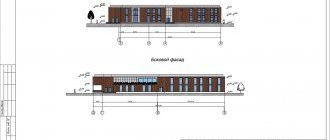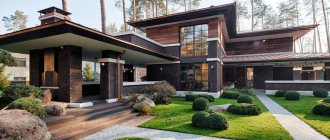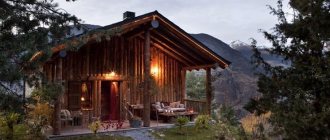Houses of the 19th century are a characteristic feature of the new era of developing capitalism. At this time, the appearance of large Russian cities was changing greatly. Technological progress and the growing new class - the large merchants, the owners of factories and factories set new tasks for architects. New types of buildings, train stations, large stores, and entertainment facilities were built: theaters, circuses. Capitalism in architecture was also characterized by the appearance of apartment buildings in cities.
19th century houses
You may be interested in:Medieval engravings: photos, description of features
Russian society of the 19th century was class-based, this influenced the houses in which their representatives lived. Much depended on the area of residence. The main categories of residential buildings of this time can be distinguished:
- Noble.
- Merchant.
- Meshchanskaya.
- Peasant.
- Profitable.
Each was distinguished by its own characteristics, which depended on the life of the representatives of the class, on wealth and purpose. So, there were city, rural houses and mansions, country estates. What was new was the appearance of country houses in the vicinity of cities, where people traveled during the summer season. The number of inhabitants in cities was constantly increasing. This is associated with the appearance of apartment buildings at the end of the 18th century, the construction of which began to rapidly develop in the 19th century.
You will be interested in: “Archival important” - how do you mean it?
Russia is a country with a huge amount of forests. Therefore, most of the houses were wooden. This was also due to the cold climate. Houses made of wood were warm and well built. In Moscow, St. Petersburg and other cities in the south of Russia, 19th-century housing was built from stone.
Decoration and furnishings
Various types of wood, such as cherry, birch, ash and pine, vary greatly in both texture and budget, and real solid wood (especially oak) can seem hefty in price. Lightening completely wooden surfaces is not only aesthetically attractive, but can also be practical.
Companion materials for surface finishing:
- Tiles. Finishing part of the wall in the fireplace area, culinary area of the kitchen.
- Bleached plaster will add light and space.
- Natural stone (granite, marble) - emphasizes the structure of wood.
Creative owners will love the idea of aging or resuscitating suitable designs themselves. Modern improvised means (there are even ready-made kits, for example, for decoupage), varnishes and paints with all sorts of effects (craquelure, patina) take the process to a new level. They allow you to create on your own that very valuable antique object that gives the room a special flavor: a china rack, a chest of drawers, a wardrobe, a chest.
Advice. Think about not just niches, but screens and doors that hide the necessary equipment for complete compliance and harmony.
For a kitchen in this unique design, manufacturers have provided solid wood furniture (or so-called solid wood), which:
- they will hide behind their facades small and large household appliances that stand out from the concept;
- for the hood, the requirements are taken into account - the shape of the chimney or a special box that hides a modification that is no longer relevant.
- household appliances in retro style, calm colors with copper and brass fittings.
Features of Russian architecture of the 19th century
Russian architecture of houses of the 19th century predetermined the appearance of modern cities. In the first half of the century, the dominant trend was classicism with its rigor, order and clear layout. He embodied the ideas of antiquity, the rigor of canons and logic. Its main feature is the Tuscan order, which is enlarged and emphasized by the severity of massive walls, colonnades and arches. This applied to both urban planning in general and individual buildings. It was replaced by eclecticism - a mixture of elements of different styles.
Where is it appropriate?
It is unrealistic to make a completely Russian hut in an apartment. Externally there can be no talk of this; inside there will only be some kind of stylization. Apartment owners will be able to add some directional features; many stop there. They decide to waste time on completely stylizing their home.
This is suitable for a log house in the interior. In this type of housing it is appropriate to place familiar elements. No one forbids using it in the interior of a wooden house; the inside will look quite harmonious.
Noble mansion
You may be interested in: What is acquisition?
The highest nobility in the cities built luxurious mansions, the construction of which attracted famous architects. Numerous family members and servants lived in them. On the ground floor there were utility rooms and servants' rooms. The second was occupied by several large living rooms, boudoirs and bedrooms. The third floor housed living quarters with low ceilings.
Mandatory attributes of mansions and estates were special rooms, the purpose of some of them is not entirely clear to modern people:
- Hallway. These premises could be found exclusively in Russian mansions and houses. In cold winters there was a large amount of outer clothing, which had to be removed and placed when entering a warm room. European houses do not have hallways. The place where fur coats, hats, and warm shoes were hung was fenced with railings. There were mirrors hanging here and chairs.
- The valet room, so named due to the fact that there was a valet on duty there. It was furnished with good quality mahogany furniture. The walls were decorated with paintings.
- Portrait room. Here on the walls hung portraits of family members or ancestors. The furniture was made of mahogany. The walls were painted in natural colors or covered with wallpaper. Often they were covered with designs imitating wallpaper.
- Cabinet. It was mandatory in 19th century noble houses or estates. As was customary, furniture was made from Karelian birch, poplar or mahogany. The walls were covered with wallpaper or painted to match it.
- Dining room. A large room where the owners dined and treated their guests. It was decorated with a large oval table, expensive furniture and paintings on the walls, which were painted in natural colors.
- Bedroom with boudoir. The hostess slept here. The bed was covered with a screen; in the corner there was usually an icon case where one could pray. The boudoir was separated from the bedroom. In it, the housewife could take care of her toilet and business: embroidery, correspondence. As a rule, there were other bedrooms for family members and guests in the house.
- Living room. The front room where guests were received. It was richly furnished, paintings hung on the walls, and upholstered furniture was installed for relaxation and conversation. The living room in the house of a 19th century nobleman was arranged in accordance with the prevailing style. It was a time of classicism with a clear rhythm and a unified style of placement of furniture and art objects. Mahogany furniture was decorated with chased items made of gilded bronze or brass. The French fashion for antique products implied the presence of statues that were located in living rooms. The decor of the room matched this. In a rich nobleman's house in the 19th century, where many guests were received, there were several living rooms.
You may be interested in: Institute of the Ministry of Emergency Situations in Minsk: address, faculties, passing grade
Foreigners were surprised by the double frames on the windows, large stoves reaching to the ceiling, decorated with beautiful tiles. The fireplaces were not lit in winter. Because cold air penetrated through them. They were closed for the winter and decorated with flowers. Foreign guests were also surprised by the huge number of flowers in the houses; they were everywhere.
Noble estate
An estate is a complex that included a residential building and various buildings: utility, gardening, stables, human and others. They fit harmoniously into the manor park. If there was no river nearby, then a lake with an island was built, alleys were laid out, rotundas were erected, ruins and grottoes were laid out. Rich estates had a church. Manor houses were arranged according to the principle of city mansions.
There is such a thing as Russian estate style. It is quite unique; it was difficult to see anything similar outside Russia; the specifics of this style were determined by serfdom and long distances from large cities. The estate had many workers who lived here. Isolation from the city left its mark, as the nobles had to take care of the household and constantly communicate with the peasants.
Rare trips to district or provincial towns were a real event. Other estates were located tens of kilometers away, so guests did not come often. Furniture purchased after the construction of the house was passed on to the heirs. Fashion and style news arrived here late. But there were estates that were built by famous architects, some of which have survived to this day. These are real monuments of Russian architecture.
Improved variation - tower
The dacha is now associated with pleasant moments, the opportunity to relax, and take a short trip. It’s not difficult to take an excursion into history, because changes and improvements are precisely aimed at enjoying the flavor without interrupting a comfortable pastime.
The upgrade applies to all wooden surfaces - they become smoother and carefully finished. Varnish, polishing, painting are allowed; parquet appears. The emphasis is on exquisite, fine carvings and ornaments. Mosaic design is present in the decoration of walls and floors.
Decorative elements also undergo changes for a more spectacular transformation:
- items are carefully painted;
- gilding, embossing - decorate many planes;
- clocks, paintings, mirrors on the walls no longer look like alien components;
- textiles - acquire delicate embroidery with decoration in the form of silver, gilded threads, beads, and pearls.
The furniture is more modern - even in the photo you can see the appearance of sofas, armchairs and those objects that, laconically fitting into the interior, are more familiar in everyday life. A simple shape, upholstery with a suitable fabric are signs that the soft group will take root in the design.
Merchant's house
The development of capitalism has led to the emergence of free capital that requires investment. The rapid construction of houses by large merchants and manufacturers begins. Merchant houses of the 19th century, owned by very rich representatives of this class, were mostly similar to palaces. Famous architects were often invited to the construction.
But for the most part, merchant houses were good-quality wooden, wood-stone and stone, which overlooked the garden and vegetable garden. The courtyards were adapted for storing goods, the furnishings were very different, there is no need to talk about any style here. Along with the paintings purchased for the occasion, there were many icons. They sought to imitate the representatives of the upper classes in everything. But for the most part, only a few succeeded, those who received a decent education.
The nobility slowly went bankrupt, selling their estates. The merchant class grew rich and bought them, adapting them to their own way of life. But most of the nouveau riche taught their children not only in Russia, but also abroad. It was already difficult to distinguish the well-educated merchant children from representatives of the upper class. They arranged their 19th century homes in Russia differently than their fathers. They knew several languages, understood painting, architecture, and literature.
Architectural features
- Form.
Despite the traditional rectangular shape of the building itself, the rich stucco molding significantly transforms the appearance of the mansion. For the interior, the main characteristic is “baroque” and a richly furnished appearance. - External "accessories".
Decorating cornices, for example, with samovars, vases with flowers and various “curls” is a classic version of Russian merchant baroque. Attic pediments in a lush and wavy design are a frequent “showcase” of beauty. - Color.
As a rule, houses were painted red, terracotta, brown and ocher. You could also often find emerald and green shades of the walls. All stucco work on the façade was whitewashed or painted in a light gray color scheme.
The most characteristic manners of the merchant style:
- a combination of baroque “curly” motifs and ancient Russian ones, there are unique local architectural solutions;
- the framing of windows (including cornices and pediments) is characterized by floridity, pretentiousness and unconventional techniques, the complete opposite of the classical and strict style;
- the tastes of the merchant class took the form of the so-called “third Rococo”, which is characterized by a peculiar theatricality;
- pomp and originality.
Bourgeois house
The bourgeois class included teachers, day laborers and hired workers. They made up the majority of the population of cities, and their numbers became especially large after 1861, when serfdom was abolished. The housing of the bourgeoisie was rented or a modest house of their own. Most often they were small, built like rural houses. Their styles corresponded to the area where they lived.
Apartment houses
The development of cities, the growth of industrial enterprises, and educational institutions have resulted in the emergence of a large number of people who cannot afford to build or buy a house. This category includes teachers, doctors, bankers, civil servants, engineers, professors, and students. They needed comfortable, well-equipped apartments that could be rented.
You may be interested in: Collider in Russia. NICA (Nuclotron-based Ion Collider fAcility) project. Joint Institute for Nuclear Research (JINR) in Dubna near Moscow
In cities, especially in St. Petersburg and Moscow, city authorities were building infrastructure. The construction of buildings where apartments were rented was carried out according to the designs of famous architects. At the end of the 19th century, there were more than 550 such houses in Moscow alone. In St. Petersburg, 80% of the buildings constructed were profitable. House owners tried to attract noble tenants. This was done for advertising purposes. The buildings used for rental apartments were built around the university. His professors and teachers rented excellent apartments here.
In addition to them, employees, young families, specialists, and doctors settled in apartment buildings. Houses were also built for less affluent segments of the population: small employees, workers, students. Where you could rent a room or a small apartment, where the cost was much lower. There were also so-called shelters, where housing was rented out - a room or a bed for the night.
Lighting is important and necessary
This can become a serious problem if the interior involves permanent residence. The abundance of wood does not have the best effect on the level of illumination - surfaces, especially those not alternating with white plaster, absorb rays of light, making the interior a little gloomy, especially in an apartment with low ceilings.
What you should pay attention to in this case:
- The presence of large windows that will not allow the interior of living rooms to turn into a bathhouse.
- Lightening areas with paint, whitewashing, because white reflects light better than others.
- Active LED lighting, which saves interiors from dim lighting, is excluded.
The following will help you avoid disturbing the authentic atmosphere:
- perforated lampshades simulating lace;
- lampshades with painting and embroidery;
- birch bark lampshades;
- imitation of candles, lamps.
For modern reading, designers have come up with enough solutions. For example, the latest trend is lamps resembling a matryoshka doll made of metal and glass. Even special retro wires can become an interesting accent, allowing historical achievements to be justified.
Advice. In the windows, all plastic elements must be replaced with wooden frames and supplemented with decorative shutters, if desired.
The curtains compensate for the simplicity of their forms with an ornament of flower garlands; lace ruffles are possible. Cornices, certainly wooden, with skillful carvings, will become an additional decoration.
Russian rural style
Village houses of the 19th century had their own styles and characteristics. They can still be found in rural areas and small towns. They were built in one, less often in two floors. Traditionally, these were four- or five-walled log houses with a gable or three-pitched roof, but in the eastern or southern regions you can find a hipped roof. A distinctive detail of the Russian rural style was the light fixture, which was located in the attic.
The house was built in two versions. The first consisted of one hut with a large entryway. The second is made up of two huts, which were called the front and back, connected to each other by a wide walkway and an entryway. All this was under one roof. The area around the house was not fenced off with a solid fence; only front gardens were built. The decoration of such buildings was carved platbands. Also, houses in the Russian style were built of brick and could be two-story.
Frivolous attitude
If you don’t want to spend time in an environment reminiscent of a museum or souvenir shop, bring only a touch of recognition through associations, and perhaps stereotypes. Numerous decorative items made from modern materials allow you to effectively fit them into almost any interior. A mirror framed with a baguette imitating wooden frames is appropriate for a loft and a true Russian style.
Bast shoes, nesting dolls, samovars, birch bark are recognizable always and everywhere. Create “a la Russe” only through ancient accents and folklore motifs - why not? Many designers reject this concept, considering it too deliberate and filled with cliches. But there is nothing wrong with souvenirs if they reflect your mood, impressions, perhaps memories of pleasant moments or interesting trips.
It is not necessary to recreate “literally” any one era, although there are distinctive features from a historical point of view:
| era | Name | Signs |
| The oldest Slavic heritage | Russian hut | Benches, chests, grips, ritual symbols in ornament, Red Corner |
| Times of Ivan the Terrible | Royal chambers, princely tower | Vaulted ceilings, stone, frescoes, four-poster bed, brocade |
| The first Romanovs | Palace Baroque | Chairs, gold and silver, stained glass |
| Peter's time | Baroque, Rococo | Enfilades, symmetry, unusual materials, Chinese motifs, porcelain |
| Catherine | Russian classicism | Libraries, art galleries |
Khokhloma, Gzhel - being expressive and original in themselves, are not considered fashionable unless special conditions are created for them - an unusual place of reproduction, non-standard art objects. The main thing is not to overdo it with their quantity and color compatibility with the rest of the environment.











